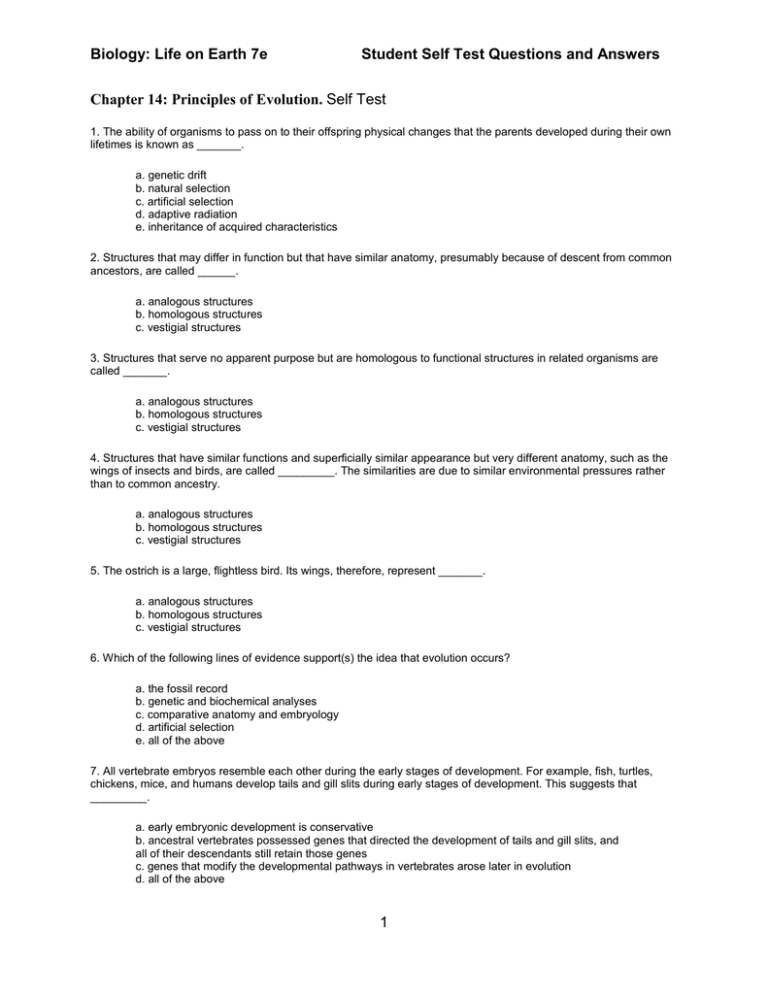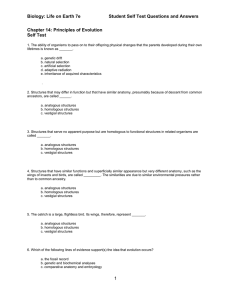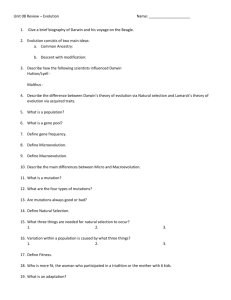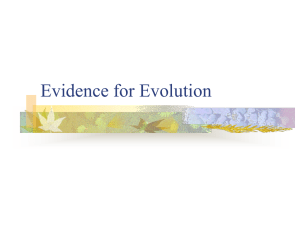Biology: Life on Earth 7e Student Self Test Questions and Answers
advertisement

Biology: Life on Earth 7e Student Self Test Questions and Answers Chapter 14: Principles of Evolution. Self Test 1. The ability of organisms to pass on to their offspring physical changes that the parents developed during their own lifetimes is known as _______. a. genetic drift b. natural selection c. artificial selection d. adaptive radiation e. inheritance of acquired characteristics 2. Structures that may differ in function but that have similar anatomy, presumably because of descent from common ancestors, are called ______. a. analogous structures b. homologous structures c. vestigial structures 3. Structures that serve no apparent purpose but are homologous to functional structures in related organisms are called _______. a. analogous structures b. homologous structures c. vestigial structures 4. Structures that have similar functions and superficially similar appearance but very different anatomy, such as the wings of insects and birds, are called _________. The similarities are due to similar environmental pressures rather than to common ancestry. a. analogous structures b. homologous structures c. vestigial structures 5. The ostrich is a large, flightless bird. Its wings, therefore, represent _______. a. analogous structures b. homologous structures c. vestigial structures 6. Which of the following lines of evidence support(s) the idea that evolution occurs? a. the fossil record b. genetic and biochemical analyses c. comparative anatomy and embryology d. artificial selection e. all of the above 7. All vertebrate embryos resemble each other during the early stages of development. For example, fish, turtles, chickens, mice, and humans develop tails and gill slits during early stages of development. This suggests that _________. a. early embryonic development is conservative b. ancestral vertebrates possessed genes that directed the development of tails and gill slits, and all of their descendants still retain those genes c. genes that modify the developmental pathways in vertebrates arose later in evolution d. all of the above 1 Biology: Life on Earth 7e Student Self Test Questions and Answers 8. Which of the following is NOT one of the main points of Darwin’s theory of evolution? a. Life on Earth is quite old. b. Evolution is gradual and continuous. c. Contemporary species share a common descent. d. Species are formed and adapt by the process of natural selection. e. All of the above are true. 9. Which of the following is a basic requirement for natural selection to be an effective evolutionary force? a. Mutation must occur frequently. b. Individuals reproduce at a rapid rate. c. Each population is limited to a small size. d. A population exhibits some genetic variability. e. all of the above 10. What does the idea of "uniformitarianism" suggest about the geological record and the age of Earth? a. Earth was only 6000 years old. b. Species were evidence of acts of divine creation. c. Earth's species were created initially but many were destroyed by successive catastrophes. d. Natural processes (e.g., sedimentation due to river flow) occurring over long stretches of time accounted for the thick layers of rock where fossils are found, rather than cataclysmic events. 11. What was the untested weakness in Darwin's manifest On the Origin of Species? a. organisms evolved through the inheritance of acquired characteristics b. natural selection c. the passage of traits from generation to generation, and that variations in these traits occurred randomly d. all of the above 12. Which of the following would be considered to be an example of analogous structures? a. molar teeth in a vampire bat b. superficially similar structures in unrelated species c. internally similar structures (e.g., of birds and mammals) that are used for many different functions d. Both the first and third answers are correct. 13. Which of the following would describe artificial selection? a. breeding organisms for the purpose of generating certain features or traits (e.g., dog breeds) b. coloration changes in guppy populations in the absence of predators c. increased frequency of roaches that avoid sugar-baited poison traps d. all of the above 14. Which of the following people allowed for species to change over time? a. Plato b. Aristotle c. Cuvier d. Lamarck 15. Charles Darwin was NOT influenced by which of the following people in formulating his ideas about natural selection? 2 Biology: Life on Earth 7e Student Self Test Questions and Answers a. Thomas Malthus b. Charles Lyell c. William Smith d. Gregor Mendel 16. Which of the following is an incorrect statement about mutation? a. Mutation introduces variation into a population. b. Mutations can be inherited from parents to offspring. c. Mutations may have no effect on the organism. d. Mutations that are favored by selection are more likely to occur. 17. You are a biologist studying a natural population of mice, and you observe that in one area the proportion of darker colored mice is greater than the proportion of lighter colored mice. In another area, the opposite is true. You find that only the area with more dark mice has predators. Therefore, you hypothesize that darker mice are favored in areas with predators, perhaps because they are more difficult to see. If your hypothesis is true, what would you expect to happen in the few generations after predators are introduced to an area with a population of mice that previously did not have predators? a. The proportion of darker colored mice will decrease. b. The proportion of darker colored mice will not change. c. The predators will evolve to be able to better see the darker mice. d. The proportion of darker colored mice will increase. 18. In what way does the human population influence evolution? a. Human development changes the habitats of many species, influencing natural selection on those species. b. Use of antibiotics by humans has selected for antibiotic-resistant bacterial populations. c. Humans are responsible for the many breeds of dogs found today. d. all of the above 19. The diagram below indicates a flowchart of evolutionary reasoning. After reading and understanding the information, label the key to indicate which boxes are observations and which are conclusions. Label A: Label B: 3 Biology: Life on Earth 7e Student Self Test Questions and Answers 20. Three major changes can be concluded from the evolutionary tree of the modern horse. Using the clues from this diagram, label the points where these three changes occurred. Label A: B and C 21. Each of these limbs shows the same set of bones (homologous structures). Using the human forearm as the key, label each of the bones. 4 Biology: Life on Earth 7e Student Self Test Questions and Answers Answer: Label A: Label B Label C: Label D Label E: Label F: 22. Outwardly similar body parts that serve a similar function in unrelated organisms (such as the wings of insects and birds) are _________. (Level 2) a. analogous structures b. homologous structures c. vestigial structures d. evidence of convergent evolution e. evidence of divergent evolution f. Both the first and fourth answers are correct. 23. Who, or what, was Charles Darwin? a. a physician b. a theologian c. a naturalist d. Both the second and third answers are correct. e. all of the above 24. Natural selection acts on ____________________, while evolution occurs in ________________. 5




